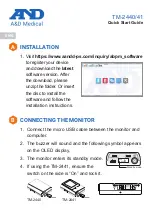
1.
Power supply circuit
Outline
This power supply unit adopts the switching mode technology, and is an off-line mode type unit that
provided several different DC outputs. The scanning frequency is available in different values ranging
from 31 kHz to 69 kHz. Moreover, it is capable to operate at an AC input voltage of 100V ~ 240V and an
AC frequency of 50-60 Hz
±
3Hz.
The block diagram is the functional construction schematics, that shows the major functions of this
power supply unit.
Harmonics (OPTION)
L107 is a harmonic choke circuit that reduces the harmonic peak currents, for the purpose of fulfilling the
requirement items of IEC 1000-3-2.
EMI
The EMI circuit has a 2-stage construction, with the first stage consisting of the common mode choke
unit and one X-capacitor, and the second stage consisting of the common mode choke unit and four Y-
capacitors.
R101 is the bleed resistor of the X-capacitor. When the power supply switch is turned OFF, this resistor
carries out the emergency charging of the capacitor C101.
The EMI is the circuit that prevents the monitor switching noise from being generated, there by minimiz-
ing the negative influence on the other electronic equipment.
AC rectifier and smoothing capacitor
The AC input is rectified by means of the full-bridge rectifier, that consists of the diodes D101 to D104.
The AC voltage is converted into the DC voltage by passing through the next stage, that consists of the
smoothing capacitor C105.
TH101 is a NTC thermistor for the power supply at the in-rush current limit.
Degaussing circuit
The degaussing circuit consists of the PTC thermistor TH102, the degaussing coil and the relay RL101.
The relay is controlled by means of the +12V control signal coming from the CPU.
Transformer and energy induction
1) When the PWM controls IC KA3842A chip, a driving pulse is generated at the gate of the transistor
Q101, and Q101 turns ON. The current returns from the “plus” (+) side of the energy-supplying ca-
pacitor C105 to the “minus” (-) side of the same capacitor C105, passing through the transformer
Q101 D-S. During the ON cycle, the energy is stored in the transformer T101. The transistor Q101
turns OFF when the driving pulse disappears from Q101. As a result, all voltages of the dot ends of
the winding flow to the positive direction and reach the fly-back rectifier. At that point of time, the
diodes of the rectifier of the secondary side turn ON, a temporary energy is induced at the secondary
side, and the ON cycle of the driving pulse is repeated.
38
Summary of Contents for MultiSync 75F-3
Page 56: ...DDC Flow Chart 53 ...
Page 57: ...Master I C Flow Chart 54 ...
Page 58: ...Master I C restart mode Flow Chart 55 ...
Page 59: ...Slave I C Flow Chart 56 ...
Page 61: ...BLOCK DIAGRAM I C bus autosync deflection controller for PC monitors TDA4857 58 ...
Page 71: ...I C bus autosync deflection controller for PC monitors TDA4857 68 APPLICATION INFORMATION ...
Page 77: ...74 8 Monolithic triple 13 5nS CRT driver ...
Page 78: ...75 ...
Page 79: ...76 ...
Page 80: ...77 ...
Page 102: ......
Page 103: ......
Page 104: ......
















































